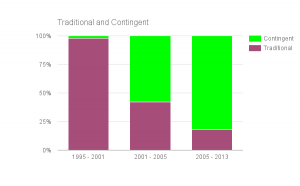
FACT: The majority of digital experience projects fail
You read that right. A recent survey by Forrester Consulting reveals that more than 60 percent of all digital experience transformations do not succeed. An even more dire stat by Consultancy.UK pegs the shocking failure rate at two thirds.
ITToday published a meaty list of Early Warning Signs of IT Project Failure. Of 53 finger-pointing items, each with their own weighted score, lack of vendor due diligence ranked #22 – scoring 5.91 out of a possible 7 as most important.
“The common thread connecting these failures is lack of due diligence.”
Project Expert: Lack of Due Diligence Can Doom Project Implementation
Interestingly, due diligence isn’t an item you see included in the how-to lists for project success – it’s just assumed. But when not done to satisfaction, it becomes the scapegoat for all that went wrong.
Plenty of advice has been dispensed on how to set yourself up for digital transformation success. Among the collective wisdom are these common points:
- Lack of executive support
- Draw a complete technology blueprint
- Deliver comprehensive project requirements
- Align communication between IT and business teams
- Set and manage expectations
- Assign accountability
- Have an adoption plan
- Recognize risks
Due diligence on a simple digital upgrade
An increasingly common digital improvement project is the addition of e-signatures to business processes. It’s an easy way to up your user experience game – and save company time and money by avoiding the paper chase for physical signatures. But how do you prevent falling into the camp of failed digital projects?
Analysts at CEB Tower Group™ tout the benefits of e-signatures and instruct how to approach this IT project for successful outcome in Why Most E-signature Initiatives Fail Before They Start.
(Hint: Aiming for cost-savings alone is a mistake.)
Incorporate these two aspects in your due diligence:
- Focus on elevating the customer experience
The main driver for the project should be enabling digital customers. Reducing hassles and meeting customers on their terms with convenient mobile options, improves the customer experience overall. E-signature technology also supports the case for streamlining internal processes, making it faster to close business, complete authorizations and service customers.
- Start small, then scale
Implementing this digital technology in discrete processes is the best way to begin. Non-customer-facing operations that are not mission-critical are fertile proving ground for the many benefits of e-sign technology: reduce errors, increase efficiency, eliminate redundancy, and of course, cut costs. Early success drives adoption in other lines of business across the enterprise, as the platform expands to support your growing operations.
Want to be among the success stories?
Have a plan for the rollout for your first 100 days, recommends CMO.com.
It’s part of the necessary due diligence that demands questions like:
- How will the project be rolled out?
- When and who will be trained?
- How will success be measured?
Beyond technical requirements, it’s critical to anticipate other factors in your due diligence – and here’s where vendors may vary greatly. Consider these important benchmarks:
Customer service
A vendor must be responsive to your need for assistance or you will be endlessly frustrated. Your service provider should have a vested interest in the success of your implementation and convey that in concrete ways when you reach out. Check unbiased user reviews to see how vendors stack up.
Pricing
Is there a more unpleasant surprise than discovering that key product features you saw in the demo aren’t included in your price? “Gotcha” pricing, overbilling, and in particular, price gouging at contract renewal time are sure signs you should be looking hard at alternate vendors.
Functionality
If your business use case varies (even slightly) from the out-of-the box offering, make sure your vendor can provide the tools to get the job done (at a price you can afford). Maintaining your brand value may be another key factor in your decision; so be sure your customers have your brand experience – not your vendor’s. And what about growth? Will your chosen solution be able to scale and grow with you as your business grows?
Yes, there is uncertainty when implementing new digital tools. But career-limiting project failure can be avoided by doing thorough due diligence. Compare multiple vendors. Ask the hard questions. Make stakeholders accountable.
The act of installing software does not a digital transformation make!
A calculated vendor decision based on careful due diligence, deep user adoption, and finally realizing benefits across your organization are what create real business change.
An alternate version of this blog was originally published here
Digital & Social Articles on Business 2 Community(82)








